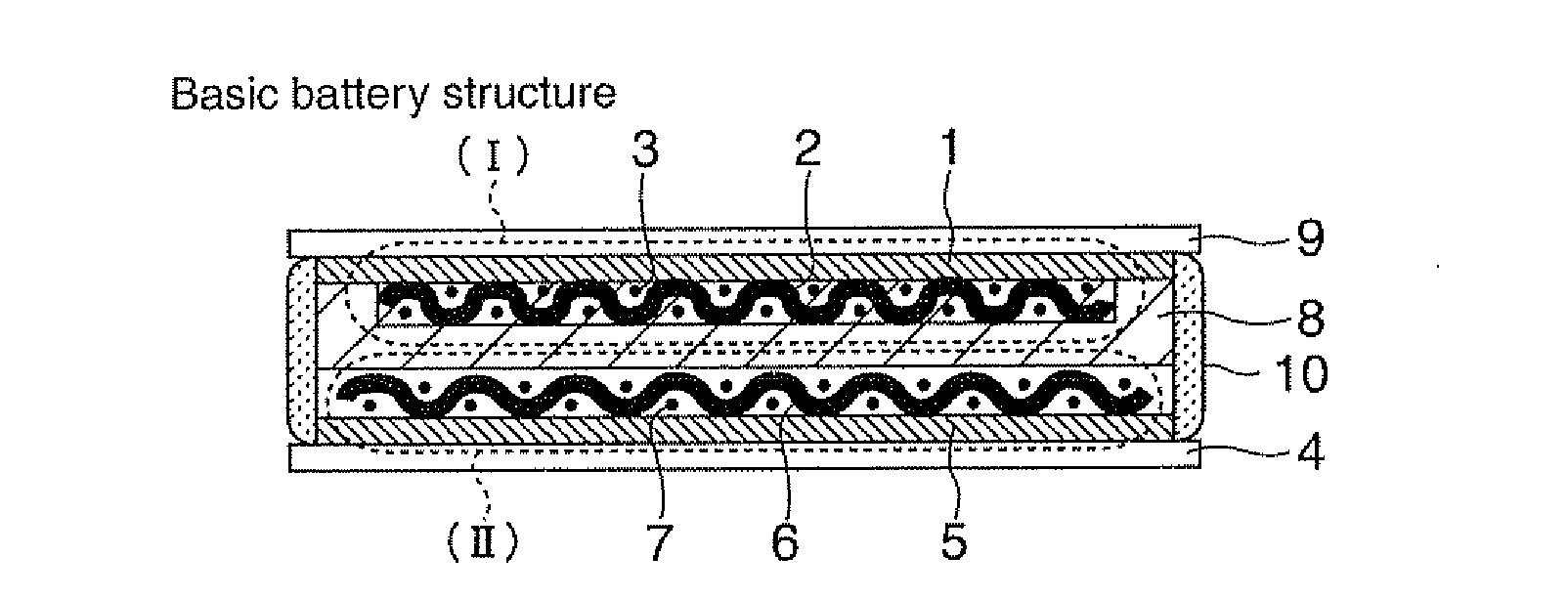Sulfide-based lithium-ion-conducting solid electrolyte glass, all-solid lithium secondary battery, and method for manufacturing all-solid lithium secondary battery
a lithium-ion-conducting solid electrolyte and lithium-ion-conducting technology, applied in the direction of glass reforming apparatus, glass pressing apparatus, final product manufacturing, etc., can solve the problems of weak bonding force, electronic bond failure, grain boundary junction failure, etc., to improve the crystallization efficiency and the effect of improving the crystallization efficiency
- Summary
- Abstract
- Description
- Claims
- Application Information
AI Technical Summary
Benefits of technology
Problems solved by technology
Method used
Image
Examples
first embodiment
[0066]Sulfide-based lithium-ion-conducting solid electrolyte in accordance with a first embodiment is vitreous electrolyte made of sulfide-based lithium-ion-conducting solid electrolyte containing α-alumina, and its base material, lithium-ion-conducting solid electrolyte, may be selected from, for example, Li2S—SiS2, Li2S—SiS2—LiI, Li2S—SiS2—LiBr, Li2S—SiS2—LiCl, Li2S—SiS2—B2S3—LiI, Li2S—SiS2—P2S5—LiI, Li2S—B2S3, Li2S—B2S3—LiI, Li2S—P2S5, Li2S—P2S5—LiI, Li2S—P2S5-ZmSn (Z=Ge, Zn, Ga))(m is integer except 0)(n is integer except 0), Li2S—GeS2, Li2S—SiS2—Li3PO4 based sulfide lithium-ion-conducting solid electrolyte glass, crystalline lithium ion conductor including any one of the foregoing compositions, and lithium-ion-conducting solid electrolyte formed from a mixture of selected ones of the foregoing compositions.
[0067]Next, α-alumina powder having a grain size of 10 μm or less that is insulating fine particles is mixed in the base sulfide-based lithium-ion-conducting solid electrolyt...
embodiment example 1
[0072]As the sulfide-based lithium-ion-conductor that is a starting base material, lithium-ion-conducting glass composed of Li2S—SiS2—Li3PO4 is used, and the first method described above is used to form novel sulfide-based lithium-ion-conducting solid electrolyte glass that contained α-alumina as insulating powder particles mixed in a weight ratio of about 7%.
[0073]The obtained sulfide-based lithium-ion-conducting solid electrolyte glass is crushed into powder having an average particle size of about 7 micron by a planetary ball mill; and the obtained solid electrolyte powder is filled in cylindrical molding jigs made of alumina each having a diameter of 1 cm which also served as an ion conductivity measuring cell, and is pressure-molded under a pressure of about 2 tons 1 cm2. At the time of the pressure application, the pressure-molding is conducted, while the jigs are heated (treated for a heating time within 2 hours) to the softening temperature range (about 200° C. 320° C.) of t...
embodiment example 2
[0074]In this embodiment example, electrolyte glass molded plates are similarly formed to investigate the relation between the heating temperature and the heating time, in heating and compression molding of electrolyte glass used in Embodiment Example 1, and their conductivity is measured, and their external appearance is examined. However, the molding pressure used in this example is the same as Embodiment Example 1, which is about 2 tons / cm2
PUM
| Property | Measurement | Unit |
|---|---|---|
| Temperature | aaaaa | aaaaa |
| Temperature | aaaaa | aaaaa |
| Time | aaaaa | aaaaa |
Abstract
Description
Claims
Application Information
 Login to View More
Login to View More - R&D
- Intellectual Property
- Life Sciences
- Materials
- Tech Scout
- Unparalleled Data Quality
- Higher Quality Content
- 60% Fewer Hallucinations
Browse by: Latest US Patents, China's latest patents, Technical Efficacy Thesaurus, Application Domain, Technology Topic, Popular Technical Reports.
© 2025 PatSnap. All rights reserved.Legal|Privacy policy|Modern Slavery Act Transparency Statement|Sitemap|About US| Contact US: help@patsnap.com



